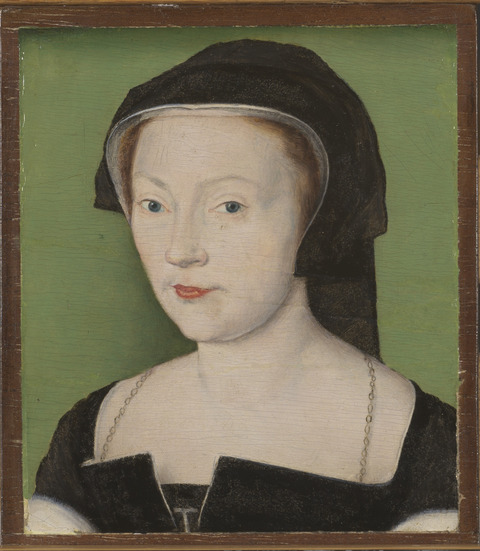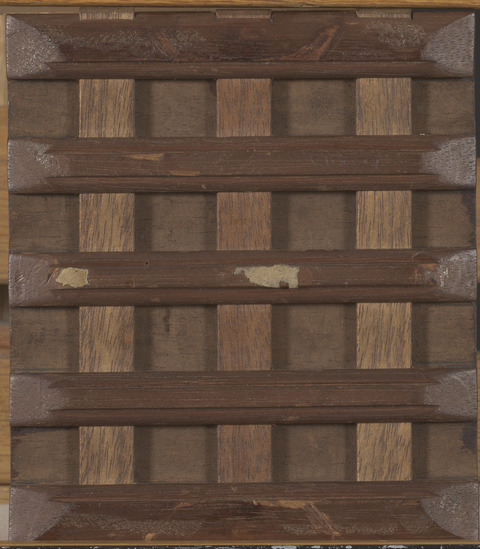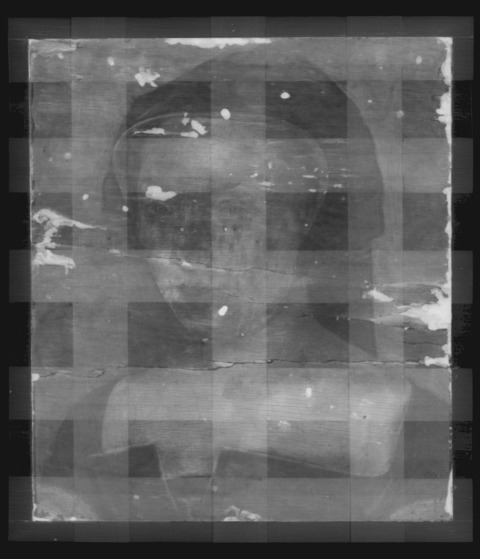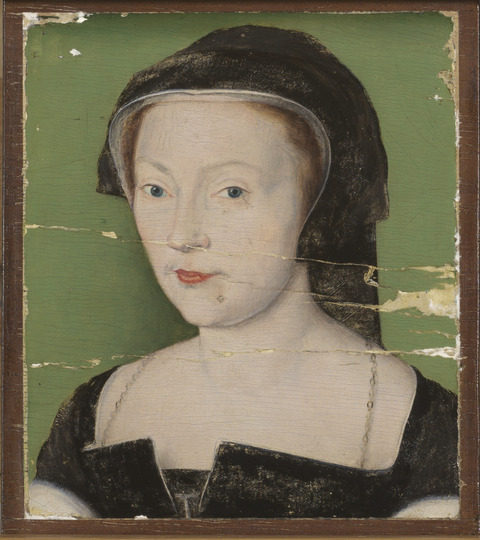Overview
Accession number: 2017.88
Artist: Workshop of Corneille de Lyon
Title: Portrait of Marie de Guise
Materials: Oil (untested) on wood panel
Date of creation: About 1537
Previous number/accession number: C10027
Dimensions:
12.5 × 10.1 cm (original panel)
13.5 × 11.6 cm (with edge strips)
Conservator/examiner: Roxane Sperber with contributions from Fiona Beckett and Gregory D. Smith
Examination completed: 2020
Distinguishing Marks
Front:
None
Back:
None
Summary of Treatment History
The painting underwent treatment in 2019–2020. This treatment involved removing discolored varnish and mismatched retouching. A new varnish was applied, and the painting was reintegrated using inpainting. No documentation has been retained from previous conservation interventions, but physical evidence suggests the painting was significantly altered from its original construction before arriving at the IMA on long-term loan in 1972. The painting was thinned, trimmed, and marouflaged to a new panel that is visible on the back. A cradle and edge framing additions were also likely attached at this time.
The painting was examined in the Clowes Collection annual survey from 2011 to 2020.
Current Condition Summary
Aesthetically, the painting appears to be in good condition. Some distortions relating to previous damage are present, but the 2020 treatment reintegrated losses to minimize their distracting appearance. Structurally, the painting appears to be mostly sound despite extensive previous damage. Past splitting and damage to the wood can be seen with raking light, but these areas are stable.
Methods of Examination, Imaging, and Analysis
| Examination/Imaging | Analysis (no sample required) | Analysis (sample required) |
|---|---|---|
| Unaided eye | Dendrochronology | Microchemical analysis |
| Optical microscopy | Wood identification | Fiber ID |
| Incident light | Microchemical analysis | Cross-section sampling |
| Raking light | Thread count analysis | Dispersed pigment sample |
| Reflected/specular light | X-ray fluorescence spectroscopy (XRF) | Fourier-transform infrared spectroscopy (FTIR) |
Transmitted light | Macro X-ray fluorescence scanning (MA-XRF) | Raman microspectroscopy |
| Ultraviolet-induced visible fluorescence (UV) | ||
| Infrared reflectography (IRR) | Gas chromatography–mass spectrometry (GC-MS) | |
| Infrared transmittography (IRT) | Scanning electron microscope-energy dispersive X-ray spectroscopy (SEM-EDS) | |
| Infrared luminescence | Other: | |
| X-radiography |
Technical Examination
Description of Support:
Analyzed Observed
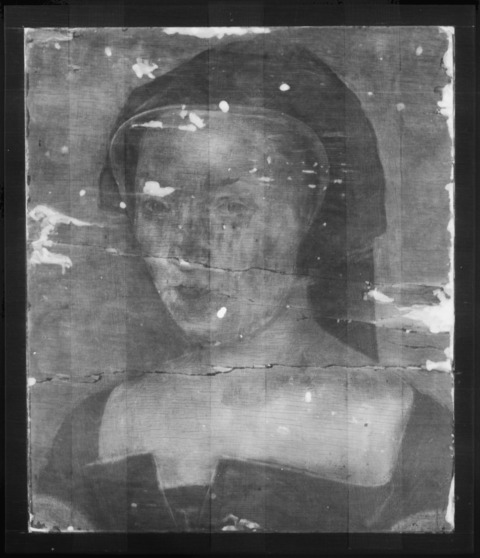
Material Type (fabric, wood, metal, dendrochronology results, fiber ID information, etc.):
The painting was executed on wood panel with a horizontally oriented grain. The grain from the original panel can be seen in the X-radiograph (tech. fig. 1).
Characteristics of Construction/Fabrication (cusping, beveled edges of panels, seams or joins, battens):
The original support was constructed from a single wood panel.
Production/Dealer’s marks:
None
Weave (structure, weight, thread thickness, etc.):
N/A
Auxiliary Support:
Original Not original Not able to discern None
The original support has been thinned and marouflaged to a new piece of wood that is 5 mm thick (tech. fig. 3: dark brown) and can be seen from the back. It is unclear if this was a full panel transfer, in which the original panel was completely removed down to the ground layer, or if the original panel was not entirely removed but rather significantly thinned and marouflaged. Due to the additions to the sides of the panel (tech. fig. 3, light brown and purple), the edges of the original panel are no longer visible. However, the thickness of the additions (4 mm), which are glued to the top of the auxiliary panel and are flush with the face of the painting, suggests that some of the original panel is still present.
A cradle with five fixed, horizontal members and three sliding, vertical members is attached to the back of the auxiliary panel (tech. fig. 2). Edge strips are attached to all four sides, with the horizontal strips extending the full width of the auxiliary panel and the vertical strips butt-joined to the top and bottom of the vertical strips. The edge strips are also similar in their grain to the painting and the added panel on the back.
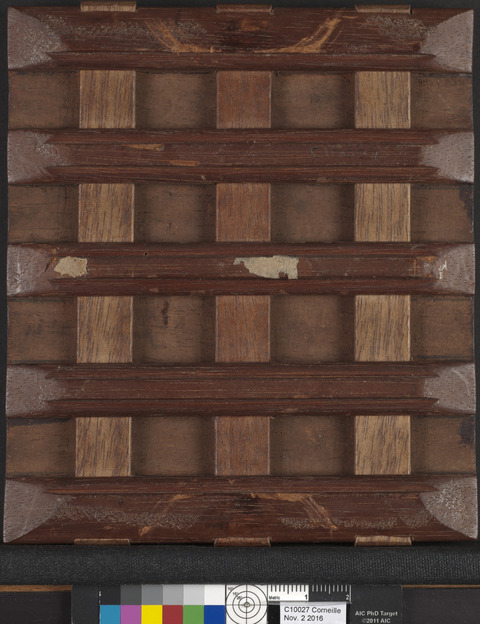
The rationale for this intervention is difficult to determine. It is possible that splits in the panel prompted the addition of the auxiliary support and cradle, but it is also possible that the constraint of the auxiliary support caused the original panel to split. Woodworm damage, although relatively minor, is another possible reason for the intervention. It is also possible that the measure was taken as a preventive intervention or as a matter of course.
Thickness (for panels or boards):

It is unclear exactly how much of the original support remains, but it is likely to be approximately 4 mm given that the edge additions attach to the top of the new panel support and are flush with the face of the painting. The total thickness of the original panel and the new panel is approximately 9 mm. The cradle is 7 mm thick (tech. fig. 3: orange).
Condition of Support
The support is currently in stable condition. The original panel suffered serious damage in the past, including two large splits across the entire width of the support, as well as losses and some insect damage. As seen from the X-radiograph, some boring holes were filled with an X-ray–dense material. Small nicks, dents, and slight wear to the wood are present around the edges. The cradle has not seized, indicating that since it was added the painting has likely been in controlled environments with limited changes in temperature and humidity. The cradle and auxiliary panel support appear to be in good and stable condition.
Description of Ground
Analyzed Observed
Materials/Binding Medium:
Cross section 2 shows the ground and imprimatura layers in an area of green background (tech. fig. 4). A layer of calcium carbonate (tech. fig. 5) ground, likely bound with an animal-skin glue (untested), has been applied to the panel, followed by a thin imprimatura layer composed of lead white (tech. fig. 6).
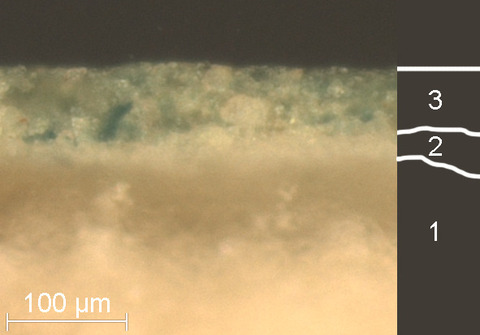
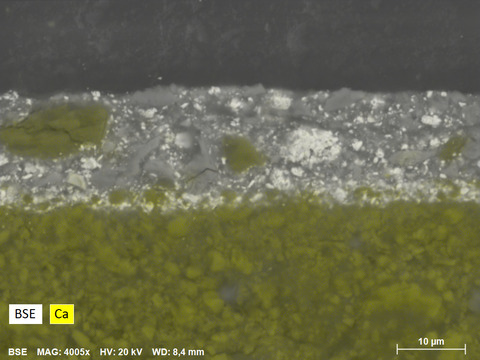
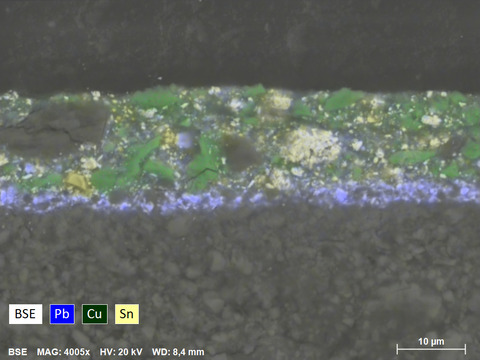
Color:
The ground is off-white (tech. fig. 4).
Application:
The ground was likely applied with a brush after the panel was coated with size. The ground was likely sanded or scraped before the application of the lead-white imprimatura, as the surface of the painting is very smooth.
Thickness:
The ground appears to have been applied in a single, relatively thin layer.
Sizing:
Although not visible in cross section, animal-glue size would have been applied to the panel prior to the ground layer.
Character and Appearance (does texture of support remain detectable/prominent?):
The ground layer is cracked in the manner typical of panel paintings and shows the texture of the wood grain throughout.
Condition of Ground
Where visible, the ground appears to be structurally stable. Aesthetically, in some areas the ground and overlying paint layers appear distorted due to previous damages. This is enhanced in raking light (tech. fig. 7). Several losses of the ground and paint can be seen in the X-radiograph (tech. fig. 1). An age craquelure pattern, consistent with the horizontal wood grain of the panel, exists throughout the ground and paint layer. Additional cracking in the top left and right corners appears as radiating stress cracks. These may be related to the thinning of the panel and the addition of the second support and cradle. There are some small, old losses in the ground around the edges of the panel.
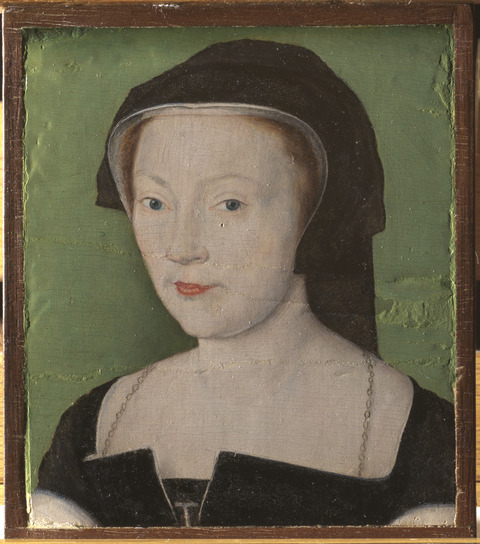
Description of Composition Planning
Methods of Analysis:
Surface observation (unaided or with magnification)
Infrared reflectography (IRR)
X-radiography
Analysis Parameters:
| X-radiography equipment | GE Inspection Technologies Type: ERESCO 200MFR 3.1, Tube S/N: MIR 201E 58-2812, EN 12543: 1.0mm, Filter: 0.8mm Be + 2mm Al |
|---|---|
| KV: | 28 |
| mA: | 3 |
| Exposure time (s) | 90 |
| Distance from X-ray tube: | 36″ |
| IRR equipment and wavelength | Opus Instruments Osiris A1 infrared camera with InGaAs array detector operating at a wavelength of 0.9–1.7µm. |
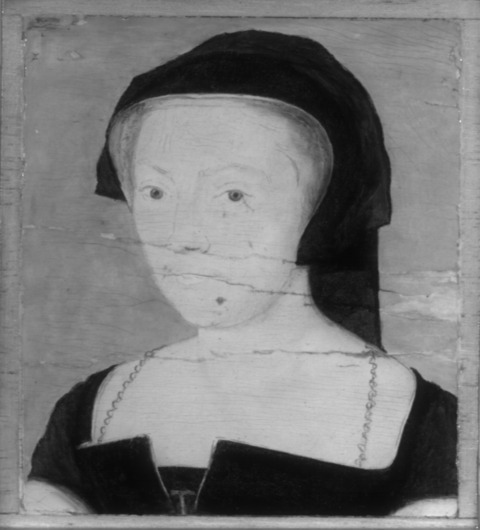
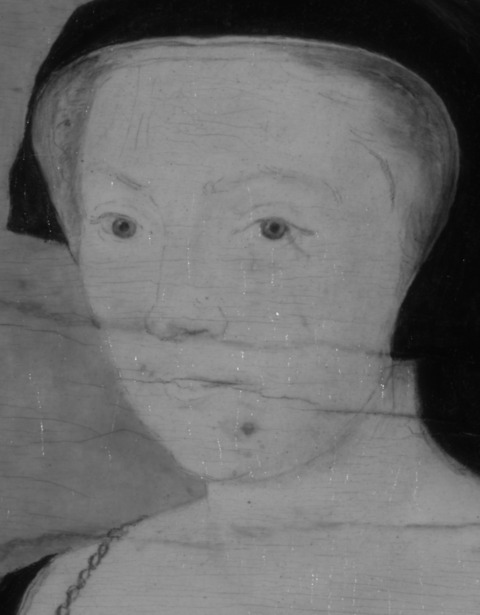
Medium/Technique:
Minimal underdrawing is visible in the infrared reflectogram (tech. figs. 8, 9). A few contours around the facial features can be observed, suggesting a minimal indication of the composition was undertaken before painting commenced. This is visible, for example, in the eyebrows, bridge of the nose, and eyes. The black paint of the sitter’s clothing would obscure much of the underdrawing in this area, but it is likely that the lines continued in these areas. The medium used for the underdrawing appears to be a dry, carbon-containing material (such as charcoal or black chalk). The lines have a delicate quality; some are visible to the naked eye, for example, in the nose (tech. fig. 11), although they appear to be somewhat reinforced by light shading with paint.
Pentimenti:
Despite the presence of discernible underdrawing, no pentimenti are obvious. The careful, delicate application of underdrawing does not suggest the artist was working out the composition on the panel. Rather, a drawing or cartoon would have been used to establish the composition. It should be noted that another version of this composition is present in the National Galleries Scotland, confirming that the Clowes painting is one in a series of this composition.
Description of Paint
Analyzed Observed
Application and Technique:
The artist applied the paint in small, careful brushstrokes over a thin ground layer and preliminary underdrawing. The features and details are delicately painted using thinly applied strokes of paint (tech. figs. 10, 11). Hints of blue are used to create subtle shadows in the sitter’s face. The green background was painted after the sitter was completed, and green paint can be seen overlapping the black headdress (tech. fig. 12). Flesh paint with a touch of red is used in the woman’s rosy cheeks and to articulate the lower eyelid. A light gray paint is used to outline such features as her nose, eyelids, and eyebrows. Gray is also used to reinforce the deepest shadows, such as the line of the woman’s chin (tech. fig. 10). A slightly darker gray was used to paint the chain around her neck.
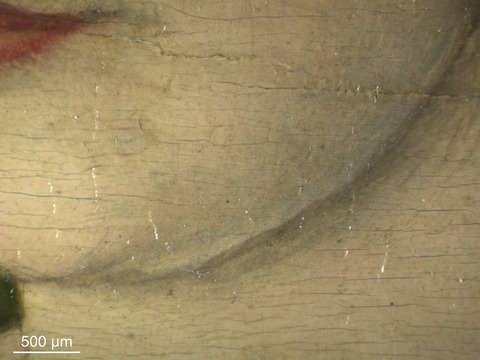
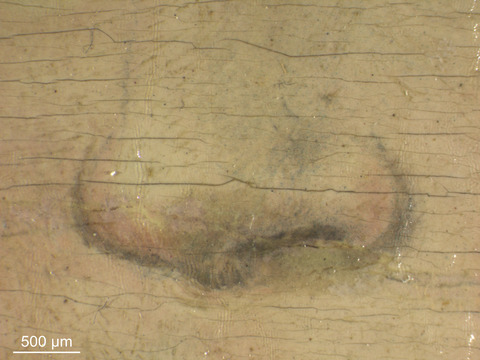
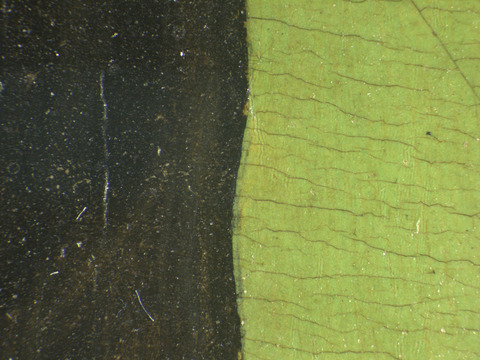
Painting Tools:
Small paint brushes
Binding Media:
Oil (untested)
Color Palette:
The palette is composed of white, black, red, brown, vibrant green, and small touches of blue. As with many portraits from the studio of Corneille de Lyon, the background is a light green color with slightly darker shading toward the edges. XRF analysis detected copper as well as tin and lead in the background, suggesting the green is composed of a copper-containing pigment mixed with lead-tin yellow (tech. fig. 17; table 1).
Cross section 2, from an area of light green background, shows the paint composition (tech. fig. 13). The layer is composed of a copper-containing green pigment, likely copper resinate or oleate, mixed with lead-tin yellow type 1 (confirmed with Raman microspectroscopy) (tech. fig. 14). Lead white does not appear to be in the mixture, as all areas of lead in the paint layer correspond to areas of tin. There are also large, transparent particles rich in calcium and magnesium (tech. figs. 15, 16). Raman microspectroscopy confirmed these particles are dolomite, suggesting that marble dust may have been added to the paint, possibly as a filler. Similar pigment compositions can be found in cross sections 1A and 2A from Portrait of René du Puy du Fou.
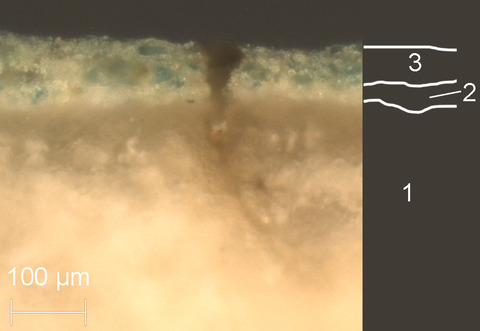
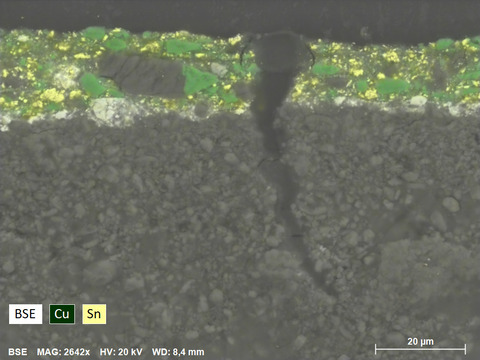
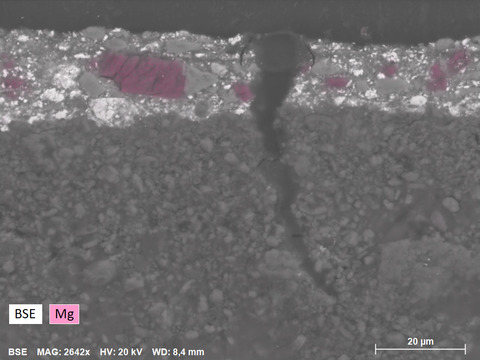
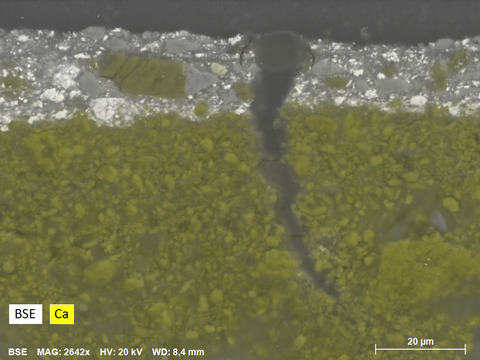
XRF analysis suggests that the skin tones were created by mixing lead white and iron oxide earth pigments with azurite to achieve the bluish undertones and vermilion to provide the pinkish hues. Not surprisingly, XRF of the red lips shows a stronger peak for mercury, suggesting the use of vermilion. The blue of the eyes yields a strong peak for copper, suggesting the use of azurite in this area.
XRF Analysis:
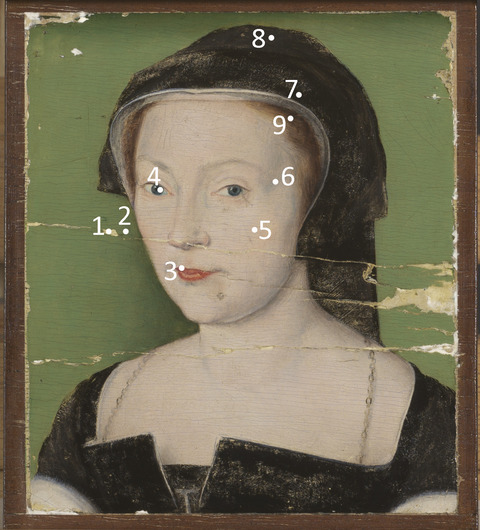
| Sample | Location | Elements | Possible Pigments |
|---|---|---|---|
| 1 | Ground layer | Major: Ca Minor: Trace: Pb, Fe, Sr, Cu | Calcium-containing ground, trace of lead white, trace of iron oxide (earth pigments), trace of copper-containing green and/or blue pigment. |
| 2 | Green background | Major: Cu, Ca, Pb Minor: Sn, Fe Trace: Sr | Copper-containing green and/or blue pigment, lead-tin yellow, lead white, iron oxide (earth pigments), calcium (from ground layer). |
| 3 | Red lips | Major: Pb, Hg, Ca Minor: Fe Trace: Cu, Al | Lead white, vermilion, calcium (from ground layer), iron oxide (earth pigments including traces of umber), trace of copper-containing green and/or blue pigment, trace of aluminum (possibly the mordant for a red lake pigment). |
| 4 | Blue eyes | Major: Pb, Cu Minor: Ca Trace: Fe | Lead white, azurite, calcium from ground layer, trace of iron oxide (earth pigments). |
| 5 | Skin tone | Major: Pb Minor: Ca Trace: Fe, Cu, Hg | Lead white, calcium from ground layer, trace of iron oxide (earth pigments including traces of umber), trace of vermilion, trace of copper-containing green and/or blue pigment. |
| 6 | Skin tone shadow | Major: Pb, Cu Minor: Ca, Fe Trace: Hg | Lead white, azurite, calcium from ground layer, trace of iron oxide (earth pigments including traces of umber), trace of vermilion. |
| 7 | Black in headdress | Major: Pb, Ca Minor: Fe Trace: Cu, P, K | Possibly bone black, small amount of bone black, calcium from ground layer, lead white, iron oxide (earth pigments), trace of copper-containing green and/or blue pigment. |
| 8 | Gray in headdress | Major: Pb, Ca Minor: Fe Trace: Cu | Likely carbon black (unable to confirm using XRF), calcium from ground layer, lead white, iron oxide (earth pigments), trace of copper-containing green and/or blue pigment. |
| 9 | Brown hair | Major: Pb, Fe, Cu, Hg Minor: Ca Trace: Mn | Iron oxide (earth pigments), vermilion, lead white, copper-containing green and/or blue pigment, calcium from ground layer. |
Table 1: Results of X-ray fluorescence analysis conducted with a Bruker Artax microfocus XRF with rhodium tube, silicon-drift detector, and polycapillary focusing lens (~100 μm spot).
Surface Appearance:
The painting is smoothly painted using very little impasto. As seen in raking light, the surface is cracked and uneven due to past interventions and a wrinkled varnish layer (tech. fig. 7).
Condition of Paint
Following the 2019 treatment, the paint layer is in good condition. During that treatment, areas of lifting were stabilized, although undulations in the paint layer could not be remedied given the painting’s physical history. The painting was likely trimmed on the edges, as most works from the Corneille studio fade to a dark green along the top and left edges. This is true of another version of this composition in the National Galleries Scotland, which may be closer to the original composition of the work.
Previous damage to the paint layer is also present along the cracks in the face and neck of the woman, and in losses in the background (tech. fig. 18). It is unclear what caused these losses, but the invasive removal of the painting’s original support and its transfer to a new wooden one were likely a contributing factor. A network of age craquelure, related to the wood grain, is present across the painting. The painting has been cleaned several times in the past, and abrasion likely removed some of the delicate nuances and shading in the face.
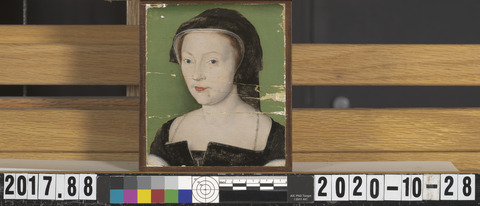
Description of Varnish/Surface Coating
Analyzed Observed Documented
| Type of Varnish | Application |
|---|---|
| Natural resin | Spray applied |
| Synthetic resin/other | Brush applied |
| Multiple Layers observed | Undetermined |
| No coating detected |
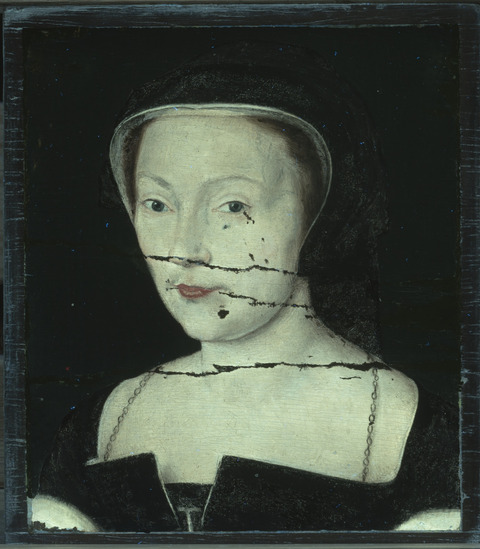
During the 2019 treatment, the painting was brush varnished with a 25% solution of Laropal A81 in Shellsol A100. The painting was inpainted with Gamblin Conservation Colors with Larapol A81 as the binder. A spray varnish of 30% Larapol A81 in Shellsol A100 was applied. Adjustments were made to the glazes, and a second spray coating was applied using the same varnish. Due to the application of a synthetic resin varnish, the painting does not fluoresce under ultraviolet-induced visible fluorescence (tech. fig. 19).
Condition of Varnish/Surface Coating
The varnish and inpainting are well saturated and well matched following the 2019 conservation treatment. The surface layers are in excellent condition.
Description of Frame
Original/first frame
Period frame
Authenticity cannot be determined at this time/ further art historical research necessary
Reproduction frame (fabricated in the style of)
Replica frame (copy of an existing period frame)
Modern frame
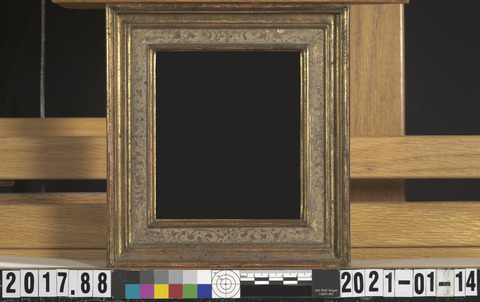
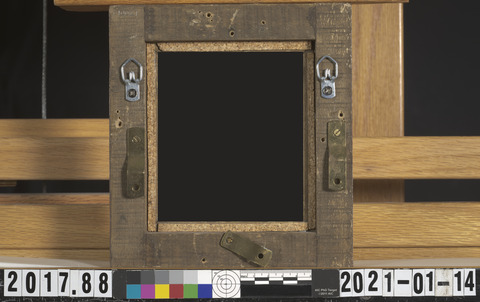
Frame Dimensions:
Golden liner frame: 19.0 × 17.5 × 2.7cm
Sight size: 12.3 × 10.5 cm
Distinguishing Marks:
No stamps or labels are present on the frame.
Description of Molding/Profile:
The frame is wooden with mitered corners on the front (tech. fig. 20) and butt joints on the back (tech. fig. 21). The front is covered in gold leaf and decorated with a toned brownish-pink paint layer over top of the gilding using the sgraffito method. An orange-red bole layer can be seen through the gilding. The decorative elements include flowers, leaves, and accentuating dots.
Condition of Frame
The frame is in stable condition. General wear is present throughout, and some abrasions are present. The mitered corners appear to be separating slightly, and cracking is present in these areas.
Additional Images
